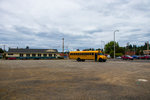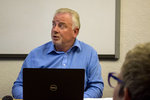

Twin Transit announced during a board meeting Tuesday that it is now focused on expanding and renovating its current building at 212 E. Locust St. rather that building a new transit center on its property at 415 N. Pearl St.
The City of Centralia sold the property to Twin Transit for $280,000 in January 2016. The approximately half-acre lot carries a current value of $207,300 according to the Lewis County Assessor’s Office, and appears to be back on the market.
Joe Clark, Director of Transit Services for Twin Transit, said Tuesday that local firms and entities from outside the Twin Cities have expressed interest in the property, but that discussions of substance have yet to take place. The Twin Transit Advisory Board met in executive session for about 30 minutes Tuesday to discuss matters related to real estate.
Clark later added that he wants to speak with Centralia city officials, some of whom are out of town this week, to see if they have any interest in repurchasing the property or any thoughts on the matter. Community Development Director Emil Pierson told The Chronicle that the property is zoned for C-3 Core Commercial District use, so what already exists downtown is a good measuring stick for the vacant parcel.
Centralia City Councilor Rebecca Staebler, who sits on the Twin Transit board and whose council district includes the downtown corridor, said Tuesday that she feels good about the future of 415 N. Pearl St.
“As a downtown person, I’m eager to see it used as something that will enhance downtown, and hopefully that will happen,” said Stabler, who also owns the HUBBUB shop currently located at 328 N. Tower Ave. “I think having that space available, there are some potentially great opportunities, I would hope, for uses that would enhance downtown. What that is, we’ll have to see. But I think the mindset is there to do the right thing.”
What’s possible and what kinds of development may be most attracted to the lot are two different categories, according to Port of Centralia commissioner Dan Keahey. Formerly a member of the Centralia City Council, he works as a real estate agent for Coldwell Banker Evergreen Olympic Realty.
Keahey sees positives, such as proximity to downtown and the lack of demolition work required for new construction to take place, as well as potential downsides to the parcel. There won’t be as much traffic driving by as there would be closer to Interstate 5, but ultimately he said it’s hard for developers to find ready-made vacant land in such a central location.
In his mind, a mixed-use building with commercial space at ground level and residential units up above would make the most sense. Many of the historic buildings in downtown Centralia feature similar floor plans.
“The people that are looking for commercial property know what they need, so you put information out like the size of the lot, the services available and some of the city development requirements,” Keahey said. “Typically, you’d have an architect draw up some ideas of how it could look, but as far as what could be there, I could throw out a lot of ideas and still miss one.”
One way in which Keahey believes Twin Transit could trim the list of possibilities is by placing covenants on the title that a buyer would have to abide by. He gave an example of when a group of people bought some taverns in Centralia and then stipulated there not be taverns on the property going forward.
Staebler said the subject of stipulations had not come up in discussions among Twin Transit leaders, and she wasn’t sure if or when they would reach that point.
“As the current owner, Twin Transit could do that with their land,” Keahey said. “They can look at the title and decide what they may or may not want to see the property used for.”
Ultimately, the hundreds of thousands of dollars Twin Transit sunk into the property by demolishing the J and L Building and the old Carpenter’s Union Building, and performing other pre-construction work on the property could prove beneficial as it looks to offload it.
“The cost of another site would come with first having to tear things down, which includes paying for asbestos abatement and dealing with environmental concerns,” Keahey said. “Those have already been done here, and those are the sorts of things commercial developers are looking for: How quickly can they start their own project, which is based on how much work the current owners took care of. It’s hard to find a location like that.”